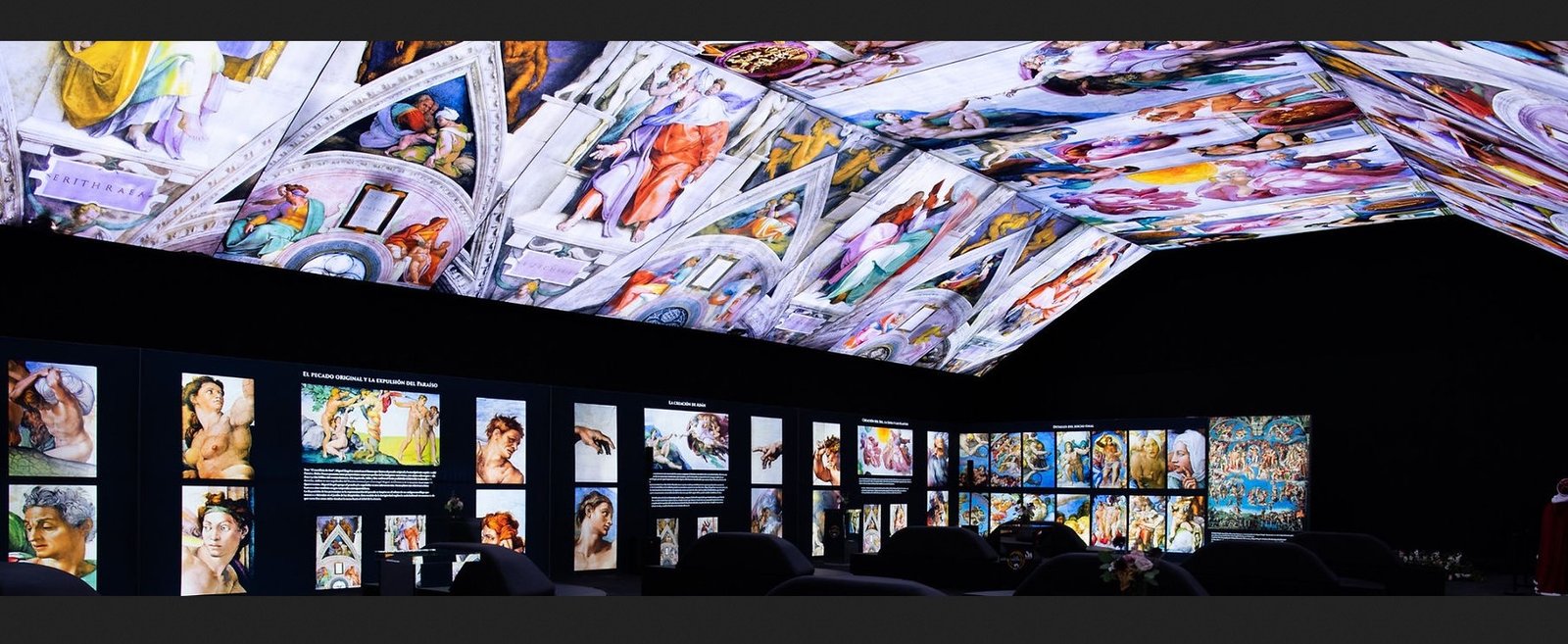Michelangelo – Art & Legacy isn’t just an art exhibition. It’s a rare moment when the past and the present speak in the same room. As someone who has spent years studying Renaissance art, I can say with full confidence: this experience offers something far more intimate than a textbook, and far more immersive than most museum visits.
From the moment you step into the space at 1212 Lincoln Road in Miami Beach, you realize this is not a conventional gallery. The atmosphere is charged — not with noise or spectacle, but with presence. The kind of presence only great art can command, even when it appears in reproduction. Because what’s offered here isn’t the original marble or fresco, but something equally vital: access to Michelangelo’s mind, his scale, his ambition.
David, Pietà, Moses – More Than Icons
The exhibition opens with full-size replicas of Michelangelo’s most revered sculptures: David, the Pietà, and Moses. We’ve all seen photos of these works. Many of us have seen them in person. But standing just a few feet away from these reconstructions, at true scale, in a controlled and contemplative environment, feels different.
David towers with confidence. It’s easy to be overwhelmed by its physicality. But stay a little longer, and subtleties emerge: the slightly tense fingers, the furrow of the brow, the twist in the torso that suggests movement is imminent. You understand that Michelangelo wasn’t simply sculpting a biblical hero. He was carving out a vision of potential — of what humans might be, when unafraid.
The Pietà, on the other hand, whispers. It doesn’t command the room so much as draw you in. Mary’s expression, her resignation and sorrow, the gentle weight of Christ’s body across her lap — it’s a composition that asks for silence. Even as a replica, the piece retains a spiritual gravity. You don’t just observe it; you stand beside it, part of its stillness.
Moses, by contrast, pulses with internal force. Seated, yet dynamic. Bearded and intense, he seems to hold the weight of law, faith, and disappointment in a single glance. Through all three sculptures, Michelangelo’s genius is undeniable: his forms are alive, never frozen. They think, feel, and almost breathe.
Bringing the Ceiling Down to Eye Level
And then there is the Sistine Chapel. Or rather, its reimagined presence in this exhibition.
Instead of gazing upward from a crowded floor, visitors walk within and around a full-scale, panoramic reconstruction of Michelangelo’s famed ceiling frescoes. The experience is stunning. Suddenly, every figure, every detail — from The Creation of Adam to the ignudi framing the scenes — becomes accessible in ways they never are in the Vatican.
The Creation of Adam, perhaps the most recognized image in Western art, hangs here with renewed power. You see the tension in Adam’s limp hand, the determined reach of God’s. The space between them — that charged, tiny gap — feels like an entire universe of possibility.
Around the central panels are the prophets and sibyls, caught in the act of reflection, fatigue, revelation. Their bodies are massive, sculptural, monumental. But their faces are human — haunted, thoughtful, wise. Up close, you realize how much of Michelangelo’s spiritual depth lies in these seemingly secondary figures. They carry stories in their posture, their gaze, their gestures.
And let us not forget the ignudi — Michelangelo’s mysterious nude youths who decorate the ceiling’s corners. They are not characters in the biblical narrative, yet they hold the entire composition together, embodying the artist’s obsession with beauty, anatomy, and mystery.
Not Just Visual — A Full Sensory Environment
What makes this exhibition exceptional is not just what you see, but how you feel it. Lighting is expertly choreographed to shift with time and tone. Music echoes gently throughout the space, creating a cathedral-like calm. The environment doesn’t distract from the works — it amplifies them.
You find yourself slowing down. Looking longer. Listening more deeply. It’s the kind of atmosphere that invites attention, not demands it. In a world of fast content, this exhibition is a masterclass in slowing down to actually see.
Hands-On Legacy: The Creative Lab
The Creative Lab section of the exhibition offers something even more powerful: participation. Visitors, especially younger ones, are encouraged to draw, sculpt, and explore artistic methods inspired by Michelangelo himself. This isn’t just an educational corner — it’s a gesture of inclusion. The message is clear: art is not just something to admire; it’s something to try, to struggle with, to make your own.
By inviting visitors into the creative process, the exhibition demystifies Michelangelo. He is no longer a distant, untouchable master. He becomes a companion, a guide — someone who also sketched, failed, studied, and returned to the marble again.
Why It Resonates Now
In our era of overwhelming speed and surface impressions, this exhibition reintroduces the power of depth. It reminds us that art isn’t about distraction — it’s about connection. Michelangelo’s figures, even when reproduced, still speak directly to human experience: strength, loss, divinity, doubt, purpose.
And perhaps that’s the most remarkable achievement of Michelangelo – Art & Legacy: it doesn’t attempt to replace the originals. It honors them by making their impact available to everyone — not through spectacle, but through intimacy.
You leave the exhibition not with a list of facts, but with a sensation. A memory of standing among giants, of seeing art not just with your eyes, but with your whole being.
And that is legacy, indeed.




